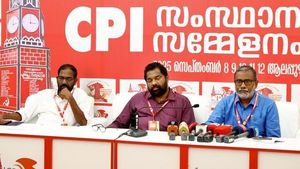More than three years after Gov. JB Pritzker signed a significant climate change initiative aimed at promoting solar and wind energy, Illinois is grappling with unexpected challenges as fossil fuel use makes an unsettling comeback. The reemergence of coal and natural gas plants has emerged as major stumbling blocks for the state's ambitious renewable energy goals, putting public health and environmental sustainability at risk.
Electricity demands, particularly from burgeoning data centers focused on artificial intelligence, are soaring, placing immense pressure on the existing power infrastructure. While the state’s prior legislation was focused on phasing out polluting energy sources, the reality is starkly different. Plants are delaying retirement dates, directly impacting Illinois's goal for 40% of electricity to be renewable by 2030, with current deliveries hovering below half of this target.
According to Brian Urbaszewski, director of environmental health programs at Respiratory Health Association, the ramifications of continued coal dependency cannot be understated. "More coal equals more emissions equals more health problems and deaths," he asserted, underscoring the health crisis linked to fossil fuel consumption.
State lawmakers are now faced with the grim reality of managing soaring electricity demands caused by AI development, as they attempt to manipulate climate and energy legislation to offset this unforeseen burden. Sen. Bill Cunningham, who is significant within state legislative efforts, noted, "No one foresaw this demand from data centers." His comments reflect the widespread lack of preparedness for the energy explosion created by modern industry.
The state's Climate and Equitable Jobs Act, aimed at reducing carbon dioxide emissions, highlighted the need for renewable sources to substitute the electricity lost from coal and gas, especially as these fossil sources are being pushed toward extended operational timelines. Urbaszewski emphasized the importance of addressing these demands through clean energy sources rather than relying on aging, polluting technologies.
Part of the problem lies with the inability to connect renewable energy projects efficiently to the electric grid, primarily due to transmission issues and the slow approval process from multistate grid operators. Across Northern Illinois, numerous clean energy projects wait patiently for connection approval.
"There are surely challenges on the horizon," remarked Will Kenworthy, Midwest regulatory director at advocacy group Vote Solar. He acknowledged the pressing need for "deliberate policy" to nurture reliable clean energy production and stressed the importance of infrastructural improvements such as battery storage. This innovation is deemed necessary to bridge gaps during non-generative periods, like nighttime or calm days for solar farms.
Illinois has been urged to rethink its strategies moving forward. Alex Gough, Pritzker's press secretary, proclaimed, "Gov. Pritzker is committed to working with the General Assembly to increase the state’s clean power supply and reduce costs for working families." This pledge indicates the administration's recognition of the hurdles yet to be tackled.
The mounting electricity demand and subsequent growth of fossil fuels contradict the initial direction of the climate law. Notably, fossil fuel firms, like Constellation Energy, recently made headlines with major acquisitions, strengthening their foothold amid uncertainty around renewable commitments. {No] T[he recent acquisition of natural gas company Calpine strongly signals the industry's expectation of continued reliance on such resources to stabilize energy supply over the coming years.
Communities across Illinois, especially those like Naperville and St. Charles, have begun to question the sustainability of their power sources, largely supplied by the Illinois Municipal Electric Agency, which still primarily uses coal energy. Libby Gardner, a 21-year-old environmental activist from Naperville, voiced her concerns, stating, "This is our future," referring to the environmental consequences of continuing these energy practices.
Despite the prevailing sentiment against coal usage, Illinois Municipal Electric has attempted to convince communities to renew long-term agreements, even pledging to incorporate renewable sources moving forward. Nevertheless, many residents remain skeptical about recommitting, fearing insufficient action to phase out coal reliance over the next two decades.
Lastly, policymakers and clean energy advocates recognize the importance of sustained growth and communication within the sector, especially when faced with political and market challenges from federal authorities. Clean energy proponents express caution against allowing environmental issues to devolve solely to political narratives. Instead, they argue this should be fundamentally about protecting consumers through access to cleaner energy.
Illinois stands at a pivotal junction as it attempts to reconcile its clean energy aspirations with immediate demands from rapidly developing technologies. The dual focus on securing electricity and fostering renewable growth will determine not only the health of its citizens but the state’s ability to meet future climate goals.



